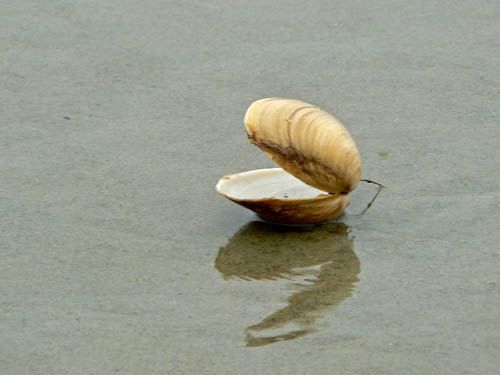Anastacia Marx de Salcedo
Guest Contributor, Slow Food Boston
Ever since the Native Americans repurposed their beach party trash as cold hard cash, the clam has had a monetary taint. In fact, over the ensuing centuries, a whole clam-based class system evolved, one whose categories hold true to this day. Want to know what your marine mollusk proclivities reveal about your social standing? Here’s the definitive guide.
WHAT’S MY CLAMITUDE?
A) Ewww! Gross!
You haven’t come to terms with your sexuality yet. (Bet you use copious soap, pre and post showers, kiss-only foreplay and lights out for the deed.)
Granted, an up-close look at mollusk anatomy can engender a certain amount of repugnance. There’re those sheathed and tubular siphons (the neck). There’re those vast gleaming membranes (mantle, muscles and, excuse me?, labial palps). And then, of course, there’s—yuck—psuedofeces.
(If it makes you feel any better, most people agree with you.)
(B) Battered ‘n’ fried.
You’re either working-class or an ironically-winking wannabe. (‘Fess up: You’ve got a baseball cap collection and knock back American Belgian beer.)
The fried clam’s blue collar rep stems not so much from the fact that it’s deep fried, but that it’s made with soft shell clams. The species isn’t the most physically attractive—their big lolling necks protrude permanently from their shells, and their preferred habitat is coastal mud. On the upside, they can be harvested with nothing more than a whistle and a song and a willingness to get squirted in the eye (ergo, their nickname, piss clams). Throughout much of US history, soft shells were the archetypical poor man’s food; their only other common use was as bait.
(C) On the half shell; cocktail sauce optional.
You belong to the upper echelons, either by dint of education, aspiration or trust fund disbursements. (Other indicators: gadgetitis and a devotion to Bikram/barefoot running/triathlons.)
Raw bar fodder is almost always from the hard shell species (the delightfully named Mercenaria mercenaria; size determines whether they’re littlenecks, cherrystones or gag-inducing quahogs), which is found in sand and in shallow bays. Acquisition of this foodstuff may require a capital investment (be it the shabbiest dinghy around), and is thus more appropriate for the higher classes. Eating them on the half shell, like their ritzy cousins the oysters, further elevates their status.
Still on the fence about where you belong? How about a taste test?
For fried clams, nothing can beat the legendary Clam Box, from the heart of soft shell clam country, Ipswich, MA. Go with an appetite and plenty of patience—lines get long!
For clams on the half shell, well, I’d rather not have to field angry emails from the over a dozen fine raw bars around town. But if you really want to know, there’s this thing called the Internet…


Anastacia, I love your writing style and the off-the-cuff quips. It seems that my clamitude alternates between fried and on the half shell, but where, pray tell, do the steamed clams fall in? I’ve seen an entire extended family (my own? perhaps.) display their gluttonous tendencies over a pot of steamers (dunked in melted butter, of course). Mmmm…clamboil.
Ouch! Wampum is a heck of a lot more than “beach party trash” and not even exactly equivalent to money in the Western sense of the word.
http://www.nativetech.org/wampum/wamphist.htm
Ouch! Maybe a little underinformed culturally there. Wampum is a lot more than “beach party trash” and it signifies much more than “cold hard cash,” in the Western sense of money. Since native people were the first people in these regions to harvest and eat shellfish, and still do so and still wear and create wampum today, it would be nice to take the opportunity to inform people about it and get beyond the simple stereotype “wampum=clam shell money.”
http://www.nativetech.org/wampum/wamphist.htm
Definitely C … occasionally B … but never A. Thank goodness! What a great article!
Anastacia,
Tasty article – brought back memories of many great summertimes on the Cape, digging clams and quahogs and eating them in all modes, raw and cooked; in recent years we’ve also learned to appreciate mussels. And we musn’t forget some yummy encounters with other mollusks – scallops and oysters. We are truly blessed to live on the east coast of our great country.